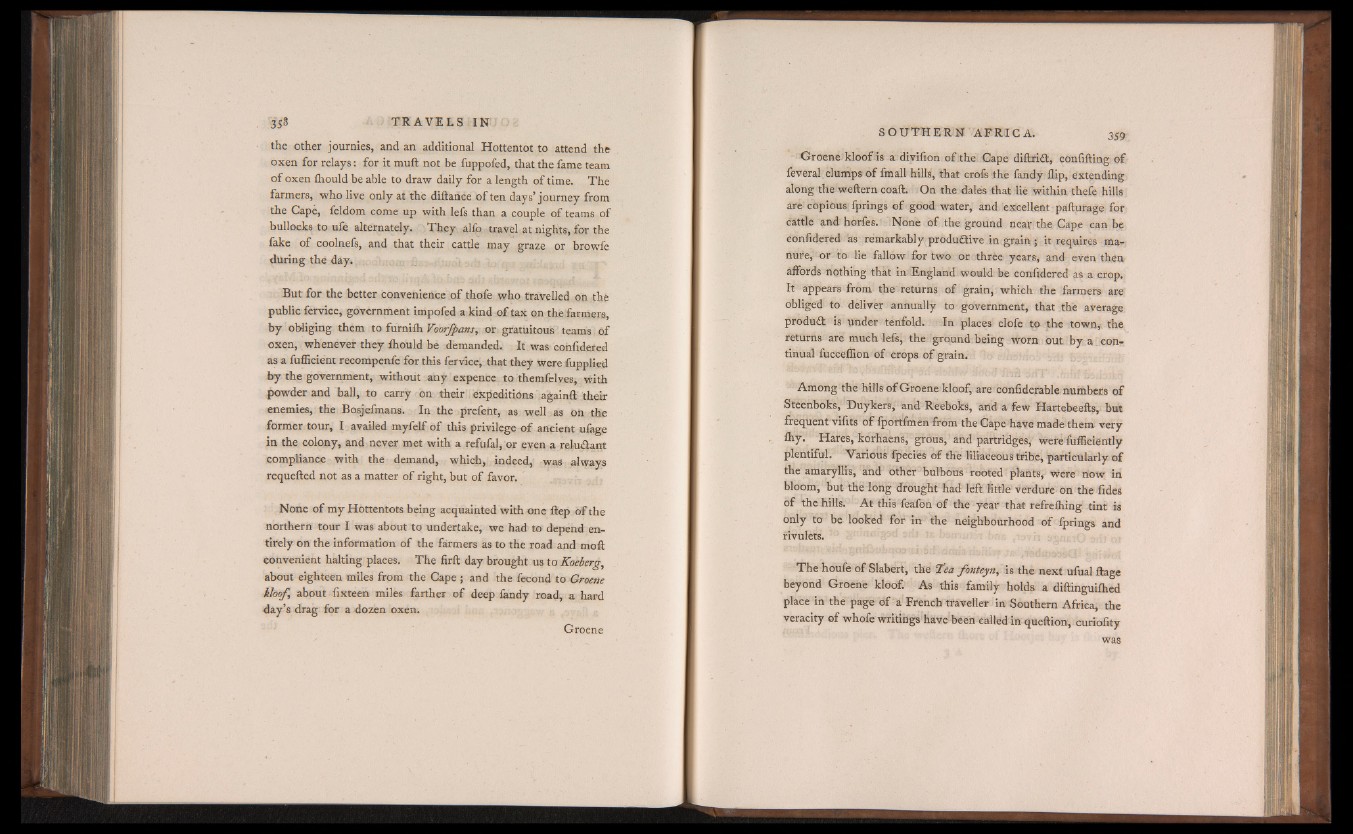
the other journies, and an additional Hottentot to attend the
oxen for relays : for it mull not be fuppofed, that the fame team
of oxen Ihould be able to draw daily for a length of time. The
farmers, who live only at the diftance o f ten days’ journey from
the Cape, feldom come up with lefs than a couple of teams of
bullocks to ufe alternately. They abb travel at nights, for the
fake of coolnefs, and that their cattle may graze or browfe
during the day.
But for the better convenience of thofe who travelled on the
public fervice, government impofed a kind o f tax on the farmers,
by obliging them to furniih Voorfpans, or gratuitous teams of
oxen, whenever they Ihould be demanded. It was confidered
as a fuflicient recompenfe for this fervice, that they were fupplied
by the government, without any expence to themfelyes, with
powder and ball, to carry on their expeditions againft their
enemies, the Bosjefmans. In the prefent, as well as on the
former tour, I availed myfelf of this privilege o f ancient ufage
in the colony, and never met with a refufal, or even a rekuâant
compliance with the demand, which, indeed, was always
requefted not as a matter of right, but of favor.
None o f my Hottentots being acquainted with one ftep of the
northern tour I was about to undertake, we had to depend entirely
on the information of the farmers as to the road and moft
Convenient halting places. The firft day brought us toKoeberg,
about eighteen miles from the Cape ; and the fécond to Groene
kloof, about fixteen miles farther of deep fendy road, a hard
day’s drag for a dozen oxen.
Groene
Groene kloof is a divifton o f the Gape diftria, confifting of
feveral clumps o f fmall hills, that crofs .the fandy flip, extending
along the weftern coaft. On the dales that lie within thefe hills
are copious fprings of good water, and excellent pafturage for
cattle and horfes. None of the ground near the Cape can be
confidered as remarkably produftive in grain ; it requires manure,
or to lie fallow for two or three years, and even then
affords nothing that in England would be confidered as a crop.
It appears from the returns of grain, which the farmers are
obliged to deliver annually to government, that the average
produft is under tenfold. In places clofe to the town, the
returns are much lels, the ground being worn out by a continual
fucceflion of crops o f grain.
Among the hills o f Groene kloof, are confiderable numbers of
Steenboks, Duykers, and Reehoks, and a few Hartebeefts, but
frequent viiits of iportfmen from the Cape have made them very
Ihy. Hares, korhaens, grous, and partridges* were fufliciently
plentiful. Various fpecies of the liliaceous tribe, particularly of
the amaryllis, and other bulbous rooted plants, were now in
bloom, but the long draught had left little verdure on the fides
of the hills. At this feafon of the year that refrefliing tint is
only to be looked for in the neighbourhood o f fprings and
rivulets.
The houfe of Slabert, the Tea fonteyn, is the next ufual ftag»
beyond Groene kloof. As this family holds a diftinguifhed
place in the page of a French traveller in Southern Africa, the
veracity of whofe writings have been called in queftion, curiofity